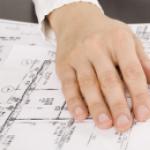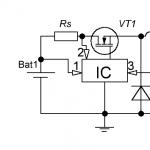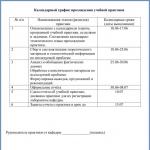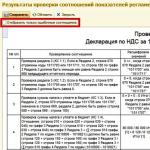The gypsum fiber sheet used today varies, it all depends on its application. There are those that can only be used for dry rooms, and there are those that are suitable for conditions of high humidity. Manufacturers offer regular and moisture-resistant gypsum plasterboard, which can perfectly replace even tiles in industrial premises, characterized by high constant humidity (before installation it is necessary to putty the walls!).
Characteristics of gypsum fiber.
In addition, GVL sheets are divided into standard and small-format. The dimensions of standard slabs are: 2500 mm - length, 1200 mm - width, 10/12 mm - thickness. Small-format sheets have dimensions: 1500 mm - length, 1000 mm - width, 10/12 millimeters - thickness. Such small sheets are very convenient to mount on walls in bathrooms and toilets using wireless frame method(after this, the walls must be puttied with special moisture-resistant compounds).
All sheets that are used for mounting on walls have a marking on the back side containing the characteristics of the sheet, its date of manufacture, and the name of the company that produced the material. Marking in mandatory should contain information on the type of longitudinal edge of the slab, the exact name of the material (regular or waterproof), the dimensions of one sheet in millimeters; designation of the group to which the material belongs.
Installation

Wall priming scheme.
Installation of GVL can be carried out on cleaned walls or after they have been putty (this depends on the condition of the wall). For this, the adhesive method is used, when the slabs are glued to the surface using gypsum putty or special glue. This can be done in several ways depending on the curvature of the wall; in some cases it is necessary to putty them first.
For the frame method, a special galvanized metal profile or wooden slats are used, to which the sheet is screwed.
The process of laying gypsum fiber sheets
Do-it-yourself installation of gypsum fiber sheets on walls can be done using two methods: frameless and frame. In the first case, the GVL slabs are glued to the surface, in the second, a special frame is first installed with your own hands, to which the sheets are screwed. Let's take a closer look at both installation methods.
Related article: Car organizer
DIY frameless installation

Stages of laying gypsum boards on the floor
For gypsum fiber sheets, the frameless method is rarely used, but for the walls of residential premises, gypsum fiber boards are the most preferable option. Installation using this method is carried out in the following sequence:
- If the walls are uneven up to 4 mm, the sheets must be glued directly to the surface of the walls using gypsum putty, which is applied in longitudinal ridges in a fairly thin layer along the perimeter of the gypsum fiber board, after which the sheet is glued to the wall.
- If the unevenness is 4-20 mm, the sheets are laid using a special glue, for example, Perflix. The composition is applied to the surface of the gypsum fiber board in the middle and along the perimeter of the slab in increments of 30-35 centimeters.
- If the unevenness is very large, from 20 to 40 mm, then installation is more difficult. First, with your own hands, using special glue, strips of gypsum fiber board with a width of 100 mm are glued to the surface of the walls, and only then the slabs themselves are glued to them using gypsum putty.
Installation using the frameless method is carried out as follows:

Scheme for attaching drywall with glue.
- Installation must be carried out before the finishing layer is laid. flooring. The room temperature should be between + 10°C. The sheets themselves should be kept in the room where the installation will take place for two to three days before work. Humidity and temperature conditions must be maintained for the entire installation period; for very wet areas such as bathrooms, it is better to use plasterboard moisture-resistant boards.
- If necessary, the walls must be prepared and cleaned of remnants of the old coating. If the surface delaminates, then strengthening measures should be taken. The wall is puttied, it must dry, after which installation can begin.
- After the puttying is completed, it should be corrected using building level verticality of the walls, presence of unevenness (the choice of installation method depends on this). The location of the slabs is marked on the surface. If necessary, the walls are treated with a primer.
- GVL slabs are cut out, holes are cut in them for switches and sockets. The height of each piece should be such that there is a gap of 8-12 mm at the bottom. After installing large slabs, small sections are installed below to bridge the gaps. To be on the safe side, the sheets can be screwed to the wall surface with self-tapping screws.
- The gypsum boards themselves are glued to the wall using special compounds according to the chosen method. This is done with a calibrating notched trowel; after applying the mixture, the sheet is leveled using a mallet. If you plan to attach any furniture to the wall surface, then glue must be applied to the entire surface of the gypsum plasterboard.
- Apply the adhesive in an even layer and constantly ensure that the installation level is maintained at the same level. This is usually done using a stretched thread. The DIY installation itself starts from the corner. Gradually, the entire room is covered around the perimeter. To cover a wall made of wood, all sheets are additionally fastened with self-tapping screws or tar nails with very wide heads.
Related article: How to make an iron door with your own hands: technology
After laying gypsum fiber sheets on the walls of the room with your own hands, it is necessary to putty all joints and fastenings with nails so that the surface becomes perfectly flat. When the mixture has dried, you can begin further finishing.
Frame installation method

Scheme of fastening plasterboard to a metal frame.
The use of a frame for fastening is based on the use of metal or wooden profiles. If wooden slats are used, then their cross-section for laying on the floor and ceiling should be no less than 30x50 mm, they are attached to the surface with screws, vertical posts should have a cross-section of 25x75 mm. The spacing of the racks should be no more than the width of one sheet of gypsum plasterboard, 400-405 mm is recommended. GVL sheets are attached to the frame with self-tapping screws in increments of 250 mm (with a width of one slab of 1200-1205 mm). To insulate the space between the frame posts with your own hands, you can lay glass wool.
The technology for laying GVL slabs on the wall requires compliance with the following conditions:
- The pitch of the screws should not be less than 250 mm.
- The length of the screw for fastening must be at least 30 mm.
- All slabs are installed with your own hands, starting from the middle of the room, in a perpendicular direction.
- A gap of 5-7 mm is left between adjacent slabs, which then needs to be puttied.
Installing a metal frame is not much different from using wooden slats, but is considered more reliable. Galvanized metal profiles with a thickness of 0.56-0.6 mm are used for this. The guide profile used is rack, corner, ceiling and ceiling guide.
Do-it-yourself assembly is carried out in this way:
- First, the wall surface must be prepared, all remnants of the old coating must be removed. As a rule, the advantages of the frame method are that the wall does not need to be prepared, but many craftsmen advise puttingtying the surface before attaching the profile.
- After this, the installation of the frame begins; a ceiling profile is used as vertical posts; a guide is used for installation on the surface of the ceiling and floor. Before performing work, it is necessary to apply markings on the wall that will show exactly where to strengthen the profile. This must be done using a building level, a plumb line and a simple pencil.
- For fastening, brackets are used, fixed to the racks with self-tapping screws; the joining of the guide and rack profiles is carried out with a cutter with a bend. The profile is attached to the ceiling with dowels in increments of 60 cm, but the increment may be smaller.
- GVL sheets are mounted in a vertical direction; a small gap should be left between them, which must be puttied after installation.
All these abbreviated names of construction products got stuck in my teeth. I just want to shout, write in full, what they are called, why and where they can be used. A homogeneous material that does not have a cardboard covering (shell), this moment is clearly visible in the photo. The area of application determines the type of sheets. Attention: Seasonal temperature changes do not cause deformation of the slabs due to the low linear expansion coefficient. Physical and technical properties For clarity, they are presented in the table:
Gypsum fiber sheet or GVL is one of the finishing materials obtained from gypsum reinforced with technological additives and dissolved cellulose. What's special about it?
Either ordinary sheets (GVL) or moisture-resistant sheets (GVLV) are used. Finishing gypsum fiber board walls with your own hands is possible when renovating a house, apartment or other buildings.
It will not be a big secret to say that modern construction prefers to use “dry” processes in the construction of houses, buildings and their subsequent finishing. All structures of walls, ceilings, and floors can be covered by these processes.
So:
| Name of material | Flammability | Density | Swelling percentage | Thermal conductivity | Flexural strength MPa |
| GKL | G1 | 0,85 | Up to 30 | 0,25 | 2 |
| GVL | G1 | 1,25 | Up to 30 | 0,25 | 5,5 |
| LSU | NG | 07 – 1,2 | 9,1 | 0,21 | 0 |
- Interior finishing with gypsum fiber boards or sheets allows you to reduce the finishing time and costs manual labor, which ultimately comes down to overall construction cost savings.
- The video materials clearly show that work with this material is carried out with ordinary tools available in every home, and its elasticity allows it to be used for cladding both convex and concave structures.
- GVL sheets and slabs are mounted on metal and wooden frames, or can simply be glued.
- The result is a flat, smooth surface, prepared for painting, wallpapering, or tiling.
- The versatility of use determines the device interior partitions, floor installation, suspended ceilings.
Application in special rooms

So:
- IN basements, having a moisture content of no more than 70%, are used in the form of bases for floors and for wall cladding, followed by tiling or painting.
- In residential areas with high relative humidity in kitchens and bathrooms, but without direct contact with water.
- Installation of partitions in storerooms and utility rooms, walls and bases under the floor.
- Sports, gymnasiums, courts where increased demands are placed on the rigidity of walls, floors and ceilings.
- Equipment for industrial and civil premises with increased fire safety requirements.
- Elevator shafts, escape routes, finishing of surfaces with specific environmental requirements. The radiation level of gypsum fiber sheets and slabs is three times less than brick products.
- Attic and attic spaces, where it is so important to avoid reinforcing seams and joints.
It can be noted that GVL slabs can be classified as complex, universal finishing materials for residential, industrial, and non-residential premises. Cladding of any internal surfaces, regardless of their components: concrete, brick, wood, flat surface or the curve doesn't matter.
Gypsum fiber material for wall cladding
GVL is produced with a polished or unpolished surface, with and without chamfered edges. Chamfers are intended to create strong but invisible seams when filling joints. GVP, without chamfers, is used when installing internal layers of wall cladding, partitions, and when joining GVP with rectangular ends, it is necessary to manually chamfer them under acute angle at 22.5ᵒ, there is no need to apply reinforcing tape to the seams.
What's special about wall cladding with GVL?
At frameless cladding walls, but it’s easier when gluing sheets to a surface, there are certain rules and instructions:
- The width of the vertical gaps between the sheets should be 5-7 mm, the distance between the sheet and the ceiling 5 mm.
- The joints of the sheets are sealed with gypsum, a special putty, without gluing reinforcing tape.
- When gluing to the wall, gypsum plaster glue and also special gypsum glue are used, which is applied in a continuous strip.
Attention: When gluing a sheet on long strips of gypsum plasterboard to unleveled walls, the pitch of the strips is not 600 mm, as with gypsum board, but 603 mm, in order to maintain a gap of 5-7 mm.
Frame construction of walls, equipment of partitions and ceilings cannot do without its own nuances and features:
- A PP profile measuring 60x27 is placed every 603 mm.
- Fastening of gypsum fiber board sheets is carried out with special double-start screws with countersink heads.
- The sheets are fixed to the frame through the same gap of 5-7 mm.
- When equipping two-layer partitions, it is allowed to attach the first layer of gypsum fiber board to the frame without gaps, but the second layer is attached to the first in compliance with the established gap of 5-7 mm.
- For the ceiling, gypsum fiber sheet (GVL) 10 mm thick is taken and most often used.
- Their installation is carried out directly on the frame of one level. This is due to the fact that the expected gap of 5-7 mm between the joints of the sheet must necessarily lie on the profile.
- The pitch of the PP 60x27 profile is 1206 mm. With a 2 mm thicker GVL, that is, its thickness is 12 mm, the distance of the attachment points is reduced to 650 mm.
Help on using the material
Gypsum fiber sheet (GVL), decorated decorative plastic refers to the most expensive, but also the most durable coating options. The material is scratch-resistant, does not react to ultraviolet radiation, does not interact with chemicals, and sanitary surface treatment is allowed.
Medical institutions, where there is a high traffic flow of people and there are increased sanitary and hygienic requirements, use this facing material and quite widely. Its price ranges from 550 rubles. 850 rub./sq. m.
They not only decorate walls, but also solve several practical problems of leveling and finishing floors.

So:
- Before laying GVL, old coatings are removed to the base.
- All loose parts must be removed from the concrete.
- If work needs to be done on several concrete slabs, joining each other, the gaps between them must be eliminated. There are modern plastic compounds on sale; it is better to putty with them.
- To determine the level of floors, measurements are taken of all corners of the room. The highest point will serve as a guide for raising the floor, taking into account the location of communications.
Dry methods are also used for outdoor work. Ventilated facades with air cushions and insulation inside, siding, but more on that another time.
Frame partitions made of plasterboard (GKL) or gypsum fiber (GVL) sheets quick and easy to install with your own hands. No need to pay for the work of installation specialists and minimal costs for finishing, make such partitions are the most inexpensive - cheap.
A frame partition is a structure made of steel profiles or wooden blocks with plasterboard or gypsum fiber sheets screwed on both sides in one or two or three layers.
The space between the sheathing sheets is filled with mineral wool for sound insulation purposes.
These partitions are lightweight, quick to install and, with appropriate design, provide a level of sound insulation that meets the standard, and even more.
Frame partitions in most cases provide better sound insulation than partitions made of stone masonry materials of the same thickness. As a result, the device, instead of interior walls from stone materials, frame partitions allows increase the space in the house.
Soundproofing partition on a single metal frame with two-layer cladding on both sides. 1 - gypsum board sheathing sheets (GSP, GVL); 2 — galvanized steel guide profile PN 50x40 (75x40, 100x40); 3 — rack profile PS 50x50 (75x50, 100x50); 4 — slabs of acoustic mineral wool; 5 - self-tapping screws; 6 - putty; 7 — reinforcing tape; 8 - dowel-nail; 9 — sealing tape;
Plasterboard partitions are installed after the construction of the house frame is completed, already under the roof. If the premises have not dried out from construction moisture and in rooms with high humidity Moisture-resistant gypsum sheets should be used for cladding.
Due to its low weight (20-50 kg/m2), partitions can be placed on the ceiling anywhere.
Partition thickness on a metal frame made of a standard profile can be from 7.5 cm. up to 15 cm.(on profile 10 cm. with double skin).
Various communications can be placed inside the partition frame. For the passage of pipes and wires in protective shells, holes are cut in the frame profiles. Some manufacturers produce profiles with ready-made holes for the passage of communications. The width of the frame profile should be slightly larger than the diameter of the pipes. The pipes must be covered with a layer of sound insulation.
To cover the partition frame in wet rooms - bathrooms, laundry rooms, boiler rooms, or in unheated ones - garage, basement, moisture-resistant plasterboard (GKLV) or gypsum fiber (GVLV) sheets are used.
The sound insulation of frame or hollow partitions increases with the mass and density of the sheathing material, as well as the width and sound-absorbing properties of the air gap between the sheathing.
The sound insulation of walls with windows or doors is practically determined by the sound insulation of the openings, which is usually lower than that of the blind part of the fence. Focus your efforts on increasing the sound insulation of doors, and then select a partition design with adequate sound insulation capacity.
The set of rules, SP 51.13330.2011 “Protection from noise”, establishes the following regulatory insulation indices airborne noise walls and partitions of residential premises Rw, dB(decibel), not less:

Specified standards are established for the mid-frequency range air noise 100 – 3150 Hz. To protect against low-frequency sounds, such as a home theater subwoofer, you need more powerful sound insulation that works specifically in the low-frequency noise range.
To ensure the necessary sound insulation of frame partitions, the following measures are taken:
- Sheathing the frame with a double or even triple layer of sheets on one, or better yet, both sides improves the sound insulation of the partition. Gypsum fiber sheets are heavier, so sheathing made from this material dampens sound better.
- Higher sound insulation will be found in frame partitions lined with massive but flexible sheet materials. Therefore, plasterboard (or gypsum fiber) sheets (density 850-1000 kg/m 3) is preferable to chipboard, MDF, OSB boards (density 700-750 kg/m 3).
- The space of the frame between the sheathing sheets is filled with sound-absorbing mineral wool slabs. Soundproofing slabs can be thinner than the width of the frame profile. The presence of some air gap between the slabs and the sheathing increases sound insulation at low frequencies. However, it is necessary to ensure the continuity of the sound-absorbing layer of slabs. Every hole or crack is an excellent conductor of sound. Special sound-absorbing slabs made of acoustic mineral wool provide an increase in sound insulation of frame partitions, depending on their design, by 5-8 dB. The use of arbitrary insulation materials in soundproofing structures leads to a much smaller effect or does not have any effect on sound insulation at all.
- The racks and guide profiles of the frame are attached to the walls and ceilings through a soundproofing elastic tape, which prevents sounds from transferring to the partition.
- The partition is performed on two independent frames only with external cladding, with laying sound-absorbing mineral wool slabs and an air gap between them according to the scheme shown in the figure below - w115.
- Sound insulation of a frame partition made of gypsum plasterboard on two independent frames 2x50 mm always higher than a partition on one frame with a width of 100 mm.

1) acoustic mineral wool AcoustCWool Concept (54 kg/m 3 ±10%, NG) is used as a sound-absorbing layer; 3) sound insulation of the original partition w111 is Rw = 41 dB; 4) w115 - two independent frames with a gap of 50 mm.

For comparison — brick partitions, made from solid ceramic bricks, plastered on both sides, have the following noise insulation index values:
- wall with two bricks (thickness with plaster 530 mm) - Rw = 60 dB;
- wall with one brick (thickness with plaster 280 mm) - Rw = 54 dB;
- half-brick wall (thickness with plaster 150 mm) - Rw = 47 dB.
- the same in half a brick from hollow ceramic bricks - Rw = 37 dB.
- half-brick wall sand-lime brick— Rw=52 dB.
- block wall cellular concrete thickness with plaster 180 mm.— Rw=44 dB.
Many people ask the question about why is the difference in Rw so small? for different partition design options?
The fact is that the sensitivity of the human ear decreases as the power of sound radiation increases. For example, if the power of sound radiation increases approximately 10 times, then a person will perceive such an increase in sound volume only twice. Sound level unit dB(decibel) is a relative value and reflects this dependence. Difference 2 dB means that the sound volume for a person will change twice, while the power of sound radiation will change approximately 10 times.
Installation of a plasterboard partition
The width of the metal frame profile, material and number of cladding layers are selected depending on the required level of sound insulation, as well as the diameter of the communication pipes inside the partition.
The standard width of the metal frame profile is 50; 75; or 100 mm. It is recommended to choose plasterboard sheets for cladding partitions with a thickness of 12.5 mm., gypsum fiber – at least 10 mm.
Sheathing made from gypsum fiber sheets is more durable and “quiet,” moisture- and fire-resistant than plasterboard. However, gypsum fiber sheets are heavier and more expensive, and the finishing gypsum fiber partition more difficult to accomplish.
It is better to choose mineral wool sound-absorbing boards with a width equal to the distance between the frame posts plus 1-2 cm. so that the slabs fit tightly between the racks. The thickness of the sound insulation boards should not exceed the width of the frame profile, otherwise the sheathing may swell over time.

The figure shows a partition with a sound insulation coefficient Rw = 53-55 dB. : 1 - soundproofing elastic tape under the ceiling profile; 2 - frame post made of profile 75 wide mm.; 3 - soundproof elastic tape under the profile on the wall; 4 - slabs of acoustic mineral wool with a thickness of 50 mm.; 5 - concrete screed of a floating floor; 6 — floating floor soundproofing slabs; 7 - soundproof elastic tape; 8 - sheathing made of two layers of plasterboard or gypsum fiber sheets; 9 - soundproof elastic tape under the profile on the ceiling;
Acoustic mineral wool slabs 50 thick mm. stacked between frame posts with a width of 75 mm. with offset - one slab is pressed against one side of the partition, and the next slab is pressed against opposite side partitions.
Installation of the partition begins with marking the boundaries on the lower ceiling or floor. Using a plumb line, the boundaries of the partitions are transferred to the walls and ceiling. Then the frame guide profiles are attached to the floor and ceiling using dowels. Dowel pitch no more than 1000 mm.
Rack profiles are similarly attached to adjacent walls. Do not forget between the profiles and the surface of the walls and ceilings of the building lay soundproofing tape made of cork, polyurethane or other elastic material.
Rack profiles are inserted into the guide profiles on the floor and ceiling and secured with self-tapping screws in increments that are a multiple of the width of the sheathing sheets - but not more than 600 mm. When used for sheathing 9.5-thick plasterboard mm. in one layer, as well as in places experiencing increased loads, it is recommended to reduce the pitch of the racks to 300 - 400 mm.
Between the rack profiles above the doorways and at the joints of the sheathing sheets, horizontal frame profiles are additionally installed. The joints of single-layer sheathing sheets, both vertical and horizontal, must be located on the frame profile.
Rack profiles along the doorway are reinforced by inserting them inside the box section of the profile wooden block or another profile.
Sheathing sheets are attached to the frame profile with self-tapping screws in increments of 20-25 cm. over the entire area of the sheet, and not just along the edges. For the first layer of double cladding, the screw pitch is increased to 60 cm. The joints of the slabs are spaced apart. Self-tapping screws must be spaced from the edge of the sheet at a distance of at least 10-15 mm. In this case, the screws in two adjacent vertical rows (when fastening two sheets on one rack) must be offset vertically by at least 15 mm.
Installation of gypsum board sheets must be done in the same direction with open part rack profile, which ensures that the screws are installed primarily closer to the wall, and when attaching an adjacent sheet, the screw being screwed in will not bend the profile flange inward.
The screws must enter the plasterboard at right angles and penetrate the metal frame profile to a depth of at least 10 mm. The screw heads must be buried into the board to a depth of at least 1 mm without damaging the cardboard.
A gap of 5 should be left between the sheathing and the ceiling mm., and between the casing and the floor - 10 mm. Joints of plasterboard and gypsum fiber sheets with a seam edge are made without gaps, and with a straight edge - a gap of 5-7 mm. In three-layer sheathing, sheets of the third layer are attached to sheets of the second layer with self-tapping screws 22 long mm.

To increase the rigidity of the partition and eliminate cracks at the joints, above the doorway, the joint of the sheathing sheets must be placed closer to the middle of the opening, as shown in the figure, where position 1 is the joints of the sheathing sheets; 2 – door opening.
After covering the frame on one side, communications are laid inside the frame, and sound insulation slabs are laid tightly between the racks without gaps. If the thickness of the slabs is less than the width of the frame profile, then soundproofing material laid in the grooves of the profiles and secured with liners made of mineral wool slabs, laid between the surface of the slabs and the internal flange of the profile.
The soundproofing board can also be glued to inside partition lining.
Communication pipes and electrical wiring passed through the lining of the partition in elastic sleeves made of porous polyethylene or other elastic materials that do not allow the formation of through cracks during temperature movement of the pipes. Where pipes pass through the partition, the layer of sound-absorbing filler should not be interrupted - pipes should be covered with soundproofing slabs at least on one side.
Electrical wires and cables are placed in the voids of the partition between the sheathing sheets in such a way that to avoid damage to the insulation sharp edges of cut frame steel or screws when attaching the sheathing. After this, the second side of the frame is sheathed.
The results of the work on installing a soundproofing partition may be unsatisfactory if you are careless and leave even small holes and cracks that are not filled with soundproofing material. Defects in the sound insulation layer are especially common at the junctions of the partition with walls, ceilings and door frame, as well as at installation sites electrical boxes and the passage of communications.
Interface, connection of frame partitions with other house structures

The pairing of two partitions at an angle of 90 degrees should be done as shown in the figure. This solution provides better sound insulation between adjacent rooms.

To ensure good sound insulation in rooms with plasterboard partitions It is recommended to install a floating floor.
The parts of the floating floor are connected to the ceiling and partition structures only through elastic soundproofing elements. Thanks to this, the floating floor does not transmit impact noise to adjacent rooms and serves as a barrier to airborne noise.
The picture above shows options for connecting a floating bathroom floor (right) and a room (left) to a plasterboard partition.
Finishing a plasterboard partition
Joints plasterboard sheets with a profiled edge and the junctions with the walls are filled with special gypsum putty. A fiberglass mesh reinforcing tape is embedded into the layer of putty along the joint.
The recesses in the places where the self-tapping screws are installed are also filled with putty. After the putty has dried, the surface of the joints is sanded. Provided the joints are carefully finished, the entire surface of the sheets does not need to be puttied.
Walls sheathed with sheets with a rectangular edge, after sealing the joints, are covered with a continuous layer (2-3 mm.) finishing putty. To fill joints the putty recommended by the manufacturer should be used purchased plasterboards. Manufacturers select the composition of the putty in such a way that, if the technology for installing the structure and sealing the seams is followed, the joint will be strong and durable.
You should not use materials that are not intended for this purpose for filling joints, for example, compositions for thin-layer finishing surface filling. Under no circumstances should such a replacement be made, since such compositions do not have sufficient strength - subsequently the seams will almost certainly crack.
At the corners of the partitions, a special metal corner profile is embedded in a layer of putty, which strengthens the corner.
It should be taken into account that microcracks may appear over time at the joints of sheets, which are difficult to disguise by painting. Therefore, for finishing plasterboard partitions It is safer to use wallpaper, tiles or other types of finishing that are not sensitive to microcracks in the base.
Soundproofing panels instead of drywall
It was noted above in the article that covering the frame with a double or even triple layer of sheets on one, or better yet, both sides improves the sound insulation of the partition. Moreover, it is more effective to use multi-layer and massive cladding sheets.
 Soundproofing panel thickness 12 mm. from corrugated cardboard. The cavities in the panel are filled with vibration-compacted quartz sand.
Soundproofing panel thickness 12 mm. from corrugated cardboard. The cavities in the panel are filled with vibration-compacted quartz sand. Soundproofing panels made of special corrugated cardboard have appeared on the construction market, which are convenient and profitable to use for cladding frame partitions as a bottom layer. The panels are sold under different brands.
The panel design contains alternating layers of materials with different acoustic properties. This ensures multiple reflection and scattering of sound waves. The friction of grains of sand under the influence of sound waves further reduces the sound energy.
The large weight of soundproofing panels allows them to effectively reduce noise, including at low frequencies.
Dimensions of one panel 1200 x 800 (600) mm., thickness 8-22 mm. and weight 10.5 - 21 kg. Panels are easy to saw hand saw or power tools. When sawing, slight spillage of filler may occur. The edge of the cut is covered with construction tape. Weight of panel thickness 12 mm. equal to 19.6 kg.(19,7 kg/m2)
 Soundproofing a frame partition with soundproofing panels made of corrugated cardboard
Soundproofing a frame partition with soundproofing panels made of corrugated cardboard The panels are fixed to the frame using self-tapping screws. After installation, the joints of the panels are puttied and taped. Drywall sheets are glued to the panels with mounting adhesive in increments of 300 x 300 mm. and additionally attach directly to panels self-tapping screws in increments of 400 mm.

The figure shows the frequency response of sound insulation of a frame partition. Light green shows the characteristics of a partition made of PS 50/50 profile with the frame filled with acoustic mineral wool and sheathed with 12.5-thick plasterboard sheets mm. in one layer on each side. The dark green color shows an increase in the sound insulation of the partition if the partition is sheathed on one side with sheets in two layers. Moreover, as the bottom layer, use soundproofing panels made of corrugated cardboard with a thickness of 12 mm.
Watch the educational film “Installation of a plasterboard partition.”
Besides, You can view and download:
- Guide to the installation of soundproofing partitions, floors, ceilings and cladding Knauf - ;
- Guide to installing plasterboard partitions on a metal frame -;
- Guide to installing plasterboard partitions on a wooden frame -.
Materials for frame partitions in your city
Dry construction materials
How to attach various objects to a frame partition
You can drive a nail or screw a self-tapping screw into a sheet of plasterboard sheathing. This mount will support the weight of a painting or mirror weighing up to 0.5 kg.
If you attach a hook to the sheathing with two self-tapping screws, then, depending on the thickness of the sheathing layer, you can hang an object weighing 2-6 kg on the hook. the distance between adjacent screws must be at least 30mm.
 Expandable dowel at the top and DRIVA screw dowel at the bottom
Expandable dowel at the top and DRIVA screw dowel at the bottom For attaching heavier objects to the casing, e.g. bookshelves, use expanding or spiral dowels. There is no need to drill a hole for the spiral dowel. It screws directly into the sheathing sheet.
Permissible point load on a special anchor embedded in a sheet of plasterboard is no more than 20 kg. or 60 kg. for two-layer sheathing.
For installing heavier objects on the partition in the places where they are attached should be installed additional profile frame or between adjacent frame posts, a plywood panel is fixed under the cladding (for example, for attaching a wall-mounted boiler, heating boiler or washbasin).

Folding butterfly dowels embedded in a sheet of plasterboard can withstand point loads of up to 30 kg.
Next article:
Previous article:
Noise insulation. Soundproofing. Acoustic. Acoustic. Vibration isolation. Noise-absorbing, vibration-acoustic. Vibration resistant. Vibration-absorbing. Vibration dampening. Viscoelastic. GKL. Metal profile. Drywall
Gypsum fiber sheet is a homogeneous material made from pressed reinforced gypsum and paper and is similar in appearance to drywall. GVL differs from gypsum board in that it is not covered with cardboard. It consists of two layers, one of which is primed.
Today, gypsum fiber is widely used in finishing premises for various purposes, including those with strict fire safety requirements. Sometimes it is simply irreplaceable. Due to its strong structure, GVL has increased strength and the sheet is suitable for creating load-bearing surfaces. Like gypsum board, it is mounted on glue.
The advantage of GVL is great strength, but the disadvantage is weight. Unlike gypsum board, it is so heavy that it cannot withstand strong stretching and deformation; it cannot be bent. The material is thicker and more expensive than gypsum plasterboard. This is an environmentally friendly product with high soundproofing qualities. It is fire-resistant and moisture-resistant, formaldehyde-free, and has the highest heat capacity. GVL sheet is warm to the touch.
Where used, sizes and markings
Like gypsum plasterboard, gypsum board is used for the construction suspended ceiling, walls and floor. Due to the properties of GVL it is used in damp, poorly heated rooms and where it is needed increased sound insulation. Experts recommend using it instead of tiles even in rooms where there is constant humidity.
When installing a floor, a gypsum fiber sheet creates a durable and warm base For finishing coating on any base - wooden, concrete or expanded clay cushion. GCR is not very suitable for this.
The choice of GVL is wide. Gypsum fiber, which resists moisture well, is used in any room, including bathrooms.
Based on size, GVL is divided into standard and small-format sheets. Dimensions standard plate: length – 2.5 m, width – 1.2 m, thickness – 10 or 12 mm. The small-format sheet is smaller: 1.5 m is the length, 1 m is the width, and the thickness is the same. It is convenient and recommended for adhesive installation on the walls of bathrooms and toilets.
Labeling with information about longitudinal edge, the name of the type of material (moisture-resistant or not), sheet dimensions, production date and company name are printed on the back side of the sheet.
👷♂️ No less important information on topic:
Gypsum fiber boards are a suitable material for covering walls. GVL is attached to the wall in the same way as gypsum boards, in two ways - frameless or framed. In the first case, they are mounted with glue, and in the second, they are fastened with self-tapping screws. The choice of method depends on the curvature and condition of the wall covering. Sometimes the walls have to be puttied, and sometimes a frame is required.

Read also:– just the facts!
Frameless installation of gypsum fiber boards
Frameless laying gypsum fiber boards It is used less often, although this method is not bad. You don't need a frame, but you will need special glue. Installation is carried out as follows:
- When the recesses are up to 4 mm deep, the sheets are immediately glued to the surface with gypsum putty. This is the so-called gypsum glue. It is applied to the sheet in thin longitudinal strips around the perimeter, and then tightly applied to the wall.
GVL glue is used. In some cases, PVA glue is used, although this option is more suitable for floors.
- If there are more irregularities on the wall (up to 2 cm), glue is used. It is spread around the perimeter and in the center of the slab in dots every 30-35 cm. When you plan to attach shelves, cabinets or other furniture to the wall, the glue is applied to the entire surface of the slab.
- If the wall is completely uneven (unevenness from 2 to 4 cm), then strips up to 10 cm wide are first glued to it, and then solid slabs are attached to them with gypsum putty. Installation on the walls is carried out before finishing the floor. The air temperature in the room should not exceed +10 degrees. Before starting work, the sheets should be kept at room temperature for 2-3 days.
For wet rooms, moisture-resistant gypsum fiber is used.
Before starting work, the walls are cleaned of weak old coating. If required, it is strengthened with a primer and puttied. Installation of the slabs begins after drying. First, the verticality of the wall is checked with a level and the places where the slabs will be installed are marked.
 Frameless method GVL installation
Frameless method GVL installation In cut according to markings GVL slabs cutouts for switches and sockets are prepared. The height of the GVL should provide gaps in the lower part of approximately 8-12 mm. They will be closed in sections after installing the main slabs. For greater reliability, the plates are tightened with self-tapping screws.
Putty and glue are applied with a notched calibrating spatula. The level is controlled by a tensioned thread. Leveling the slabs is done with a mallet directly on the wall.
Plates are placed along the perimeter of the wall, starting from its corner. For cladding wooden walls Additionally, self-tapping screws or roofing felt nails are used.
Frame installation of GVL
The frame is made of wooden slats made of material with a cross-section of no less than 3.0 x 5.0 cm. The transverse size of the vertical posts is 2.5 x 7.5 cm. The fastening spacing does not exceed the width of the gypsum board, recommended - 40 cm. The gypsum board is mounted on self-tapping screws with a length of at least 30 mm in increments of 25 cm (with a slab width of 1.2 m). Glass wool is used for insulation.
The slabs are installed starting from the middle of the wall. A small gap is left between them, about 5-7 mm.
The metal frame is much more reliable. It is made from galvanized guides and load-bearing wall and ceiling profiles with a thickness of 0.56-0.6 mm, and installation is similar to lathing under plasterboard sheets.
Assembly is carried out as follows:
- The surface is being prepared. The old coating is removed. True, not all masters advise this, considering it an unnecessary waste of time and effort.
- Using a level, plumb line and pencil, mark the wall. For vertical racks take a ceiling profile. The guides are mounted in areas adjacent to the floor and ceiling.

- The brackets are attached to the racks with self-tapping screws, and the profiles are aligned using a folding cutter. The profiles are attached to the ceiling with dowels in increments of 60 cm or slightly less.
- GVL are installed from bottom to top or top to bottom with a small gap between them.
After installation, the resulting surface is treated with gypsum putty, the joints and places where screws are screwed in are completely covered.
GVL: arguments for and against
If you compare gypsum fiber with plasterboard, you will immediately notice the identity of the materials. They are made from the same raw material (gypsum) and use different technologies. Both materials are intended for interior decoration. They have similar high performance environmentally friendly, equally resistant to moisture, and under certain conditions resistant to fire.
Thus, the material is chosen depending on the capabilities of the wallet and the purpose of the room. GVL has the following advantages:
- Strength. This is strong material. It can withstand severe compression loads. Drywall is more fragile in this regard. GVL is tougher to work with and does not crumble. Drywall breaks during transportation, loading and unloading and absorbs moisture.
- Moisture resistance is one of the advantages of gypsum fiber.
- GVL is more environmentally friendly. The structure of gypsum fiber does not collapse over time and does not create dust in the room.
- It is not flammable, whereas simple drywall is treated to achieve such indicators.
- It has the highest heat capacity and sound insulation. Where insulation and silence are needed, GVL cannot be replaced by anything.
The video shows the installation of GVL in the bathroom:
The disadvantages of GVL include the following:
- Weak in bending and not suitable for creating curved structures.
- It is not plastic, so it is not widely used.

GVL is an excellent material. It is perfect for interior work in any premises, including bathrooms, toilets, installation of suspended ceilings, construction of fences, partitions and similar structures.
They purchase GVL in a specialized store after consultation with a seller or specialist who will recommend the appropriate material. They buy it without any reserve, since there is no waste of material during installation.
Gypsum fiber sheets - universal material, ideal for leveling walls, making partitions and various indoor structures.
Made from natural gypsum and natural cellulose, it is absolutely environmentally friendly and safe for health.
The breathable structure of the sheet ensures optimal humidity, air exchange and a comfortable indoor microclimate.
Figure 1. Walls lined with GVL.
TOP 3 best products according to customers
Types and advantages of GVL
Gypsum fiber sheets are a pressed material with a homogeneous structure.
There are two types of gypsum fiber sheets on sale: GVL and GVLV.
For cladding walls and installing partitions in living rooms, ordinary gypsum fiber sheets - GVL - are suitable.

Figure 2. GVLKnauf.
In rooms with high humidity it is necessary to use moisture-resistant sheets - GVLV.
It is possible to use moisture-resistant gypsum fiber sheets in bathrooms, unheated and damp basements, garages, industrial and warehouse buildings.
GVL sheets are available with straight and folded edges.
Sheets with seams are intended for wall cladding; those with straight edges are used for dry floor screeds.
Standard dimensions of gypsum plasterboard for walls, in millimeters:
- length—1500, 2000, 2500, 3000;
- width—500, 1000, 1200;
- GVL thickness - 10, 12, 15, 20;
Gypsum fiber sheets are much stronger than gypsum boards, due to the cellulose reinforcing fibers present in the sheet mass, and have many advantages:
- fire-resistant material, does not support combustion;
- you can hammer nails and screw in screws;
- it can be sawed well with a hacksaw, an electric jigsaw, or a grinder; it can be processed with a plane;
- not subject to temperature expansion;
- reduces labor costs and finishing time;
- suitable for any finishing materials;
- compatible with all types of adhesives and putties;
- are easily mounted on wooden and metal frames, forming a perfectly flat surface.
Disadvantages of GVL:
- rigid sheets are not suitable for cladding curved structures;
- high cost;
- heavy weight compared to gypsum board.
Installation methods
Gypsum fiber sheets can be mounted on a frame made of metal profiles or wooden blocks, as well as directly on the wall, using putty, polyurethane foam or special adhesive mixtures.
The metal frame is superior to wood in many technical and operational characteristics:
- resistant to external influences, not affected by fungus, mold and pests;
- easy to install;
- does not burn;
- not subject to deformation;
- strong, reliable and durable.
Metal profiles are divided into guides and main ones.
Horizontal guide profiles are marked with the letters PN. This is the base of the frame to which the vertical main posts are attached.
The main racks are marked with the letters PS. Gypsum fiber sheets are hung on them.

Figure 3. The rack profile is inserted into the guide profile.
A wooden frame is cheaper than a metal one, but has a number of significant disadvantages:
- affected by pests and microorganisms:
- subject to deformation and shrinkage:
- flammable
The frame is needed to insulate and soundproof walls and partitions, in case of significant unevenness of the walls, to use the space for laying utility lines under the cladding.
The frameless method of installing gypsum fiber boards is used if there are minor unevenness of the walls, up to 50 millimeters.
Installation of GVL on a metal frame
Before starting work, we clean the floor, walls and ceiling of construction waste, dirt, possible influxes of concrete or mortar.
The work is performed in the following sequence:
1.Marking the frame
Before proceeding with the installation of profiles for wall cladding or installation of partitions from gypsum fiber sheets on the frame, it is necessary to carry out horizontal and vertical markings of the surfaces of walls and ceilings, drawing installation lines for profiles and attachment points for suspensions.

Figure 4. Marking the wall for gypsum board sheathing.
To do this, we use a laser level or a plumb line and a tape measure.
We draw the lines using a tapping cord and a pencil.
- We determine the distance from the profile to the wall based on the thickness of the insulation and the location of the engineering systems and put marks in the corners. Using a cord and a pencil, transfer the marks to the floor, marking a horizontal line. Using a plumb line, we transfer the line to the ceiling. We will mount the main horizontal profile along the resulting parallel lines.
- We determine the installation locations of vertical support profiles based on the width of the sheets and place marks along the perimeter of the premises. We divide the resulting segments into sections of 400 - 600 millimeters, obtaining the installation step of the vertical profiles.
- We mark the attachment points of horizontal jumpers and plumbs by breaking vertical stripes into segments of about 500 millimeters.
Important!
Markings should be carried out strictly according to the level to avoid deformations and the formation of cracks after finishing work is completed.
2.Installation of the frame
We attach the upper and lower horizontal profiles to the ceiling with screws and dowels, at intervals of about 50 centimeters.
To the walls, according to the established marks, we attach distance brackets for installing vertical racks, in increments of 50 - 100 centimeters.
We cut the rack profiles into pieces, equal to the distance from floor to ceiling. We insert the upper and lower ends of the profiles into horizontal profiles.
We fasten the vertical posts with self-tapping screws to the side walls of the horizontal profiles and the legs of the brackets. We bend the protruding parts of the legs or cut them off with a grinder.

Figure 5. Installation of a galvanized metal frame.
We tie the vertical posts with horizontal jumpers at right angles using “crab” connections.
Important!
Attach profiles and hangers to the wall through an elastic damper sealing tape, dampening vibrations and impact noise, leveling out minor unevenness in walls and ceilings.

Figure 6. Gluing the sealing tape.
3.Insulation and sound insulation
Between the profiles we lay mineral wool insulation on a synthetic binder. We install rigid slabs in a spacer, and fasten the rolled material using umbrella dowels or glue.
We close the insulation on top vapor barrier membrane. It will protect the insulation from moisture penetrating through the plasterboard from the room. IN living rooms you can do without a vapor barrier device.

Figure 7. Insulation and insulation of an external wall.
We glue vibration-isolating porous tape onto the profile.
4. Fastening gypsum fiber sheets to a metal frame
When purchasing gypsum fiber boards, consider the height of the premises to avoid transverse joints.
Important!
Before installation begins, gypsum board sheets must be kept in the conditions where installation will take place for at least four days. So that the material adapts to the humidity and temperature of the room.
You need to start installing the sheets from the window or door.
We set the gypsum board strictly according to the level so that the edge of the sheet is located strictly along the center line of the vertical profile. Sheets can only be joined using profile posts. We fix it with self-tapping screws, 25 millimeters long, in increments of 20 centimeters along the perimeter of the sheet.
With a two-layer sheathing, the pitch of the self-tapping screws for fastening the first sheet can be up to 750 millimeters.
We fasten the next sheets in the same way, making a gap between the sheets of 4-5 millimeters.
To attach drywall around the window, place the sheet in place and draw the perimeter of the opening from the inside. In this case, the edge of the sheet should be no less than 20 centimeters away from the opening.
Using the marked lines, we cut out the opening and fasten the sheet in place.
When installing slopes from gypsum plasterboard, we cut out the elements to size and attach them to the frame.
Important!
When screwing self-tapping screws into gypsum boards, it is important to recess the caps by 1-2 millimeters. To do this, it is better to install a limiter on the screwdriver.
When covering walls with multi-layers, we shift the sheets of the subsequent layer relative to the first by at least 400 millimeters in horizontal joints, and by the step of the racks in vertical joints.

Figure 8. Layout diagram of gypsum fiber board in 2 layers.
To protect the outer corners of GVL from mechanical damage, we attach metal perforated profiles made of galvanized steel to the corners.

Figure 9. Fastening a galvanized perforated profile.
Internal corners must be puttied using reinforcing tape bent in half.
After completing the cladding, seal the joints of the screws, corners and seams between the sheets with putty. To prevent cracking of the putty, we pre-glue the seams with reinforcing tape. It is better to use mesh tape, serpyanka, with back side adhesive composition.
When using serpyanka, glue it to the seams between the sheets, and then apply putty.

Figure 10. Gluing serpyanka to gypsum board seams.
We glue paper or non-woven tapes to the seams filled with putty. We also apply a thin layer of putty on top of the tape and level it with a spatula.

Figure 11. Sticker of reinforcing tape.
Grind the dried putty with fine sandpaper or with a special mesh and, if necessary, putty again.
We sand again, remove dust and prime with a penetrating primer.
Wooden wall cladding
You can veneer wooden walls according to metal frame, wooden slats or polyurethane foam.

Figure 12. Cladding wooden walls with gypsum fiber board over wooden sheathing.
Wooden slatted sheathing - best option for a wooden house. It slightly reduces the size of the room compared to a metal frame.
For the wooden frame, coniferous bars treated with antiseptics and fire retardants are used.
For constructing the frame of partitions, a block with a cross-section of 60x50 millimeters is suitable; for cladding walls without insulation, a cross-section of 25x40 is sufficient.

Figure 13. Cladding wooden walls with gypsum fiber board over wooden sheathing.
The frameless method of wooden walls made of timber is allowed.
Frameless method of fastening GVL
To determine the possibility and option of attaching sheets directly to the wall, without installing a frame, you need to check the curvilinearity of the walls using a plumb line and a two-meter lath.
If the curvature of the walls is more than 50 millimeters, fixing the gypsum board with glue is not advisable. This method of fastening is not suitable for cladding rooms with a height of more than three meters.
Before starting work, we carry out preparatory work:
- We clean the wall surfaces from old finishing materials, oil contaminants, dirt and dust.
- we seal cracks, voids and depressions with repair compounds;
- We impregnate the wall surfaces with primer twice.
To prevent moisture from getting on the sheets and to prevent shrinkage deformations, we leave technological gaps at the top and bottom of the wall, placing sheet cuttings or wooden blocks at the bottom.
Liquid nails, putties, silicone sealants, tile adhesive or any gypsum and cement mixtures.
When attaching gypsum fiber sheets to polyurethane foam, it is advisable to purchase it with a minimum coefficient of expansion, and when gluing the sheets, immediately fix them firmly.
The porous structure of GVL has good adhesion and provides reliable adhesion to any binder.
We begin installing the sheets with glue from the corner of the room, pressing the sheets along the entire plane to the wall and controlling their verticality with the help of a strip and a plumb line.

Figure 14. Frameless method of fastening GVL.
Depending on the curvature of the walls, we choose fastening methods:
- If the unevenness of the walls is more than 20 millimeters, we first attach leveling strips of gypsum board or gypsum fiber board, at least one hundred millimeters wide, to the walls, then with a notched trowel we apply glue in even continuous strips to the sheets in the places adjacent to the leveling guides.
- If unevenness is up to 20 millimeters, apply glue in molds to the sheet with an interval of 250 - 350 millimeters. At the same time, we apply support beacons from the solution on the wall, three or four marks in a row, with a distance between rows of up to 600 millimeters.
- For absolutely smooth walls, apply the glue in a thin continuous layer, leveling it with a notched trowel.
The choice of cladding method depends on the wall material, individual requirements and financial capabilities.
Different fastening methods allow you to achieve a smooth, durable base for any finishing. It is important to complete the work strictly following building codes, rules and installation technology.


















